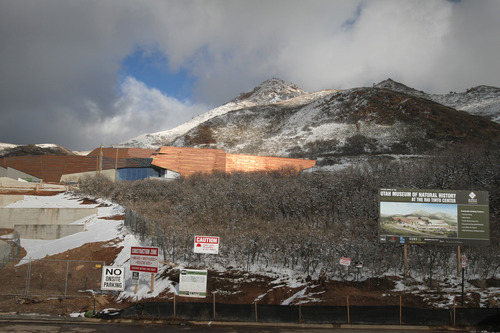This is an archived article that was published on sltrib.com in 2010, and information in the article may be outdated. It is provided only for personal research purposes and may not be reprinted.
The Utah Museum of Natural History will set aside a piece of nature at its Research Park location in a deal that nets the state $1.2 million and keeps a gambel-oak-covered slice of the Wasatch foothills free of pavement in perpetuity.
The University of Utah will sell a conservation easement on 5.27 acres near the museum's new copper-clad home under a deal U. trustees approved Tuesday. The boot-shaped parcel fronts Colorow Drive and wraps around the south and west of the museum's parking lot. It will preserve foot paths between the Bonneville Shoreline Trail and Colorow, where officials hope to develop a trailhead.
"It's a fabulous opportunity for education. We'll be expanding our school programs and taking people into that oak grove," said museum director Sarah George.
A private donor is putting up $1 million, while Salt Lake County is putting up the remaining $200,000, tapped from its open-space bond fund. The proceeds will be used to support the $100 million project to build the new museum and its installations.
"There is an old-growth gambel oak stand that would otherwise be compromised if not destroyed," said Salt Lake City lawyer Patrick Shea, who sits on the committee that oversees the county's Open Space Trust Fund. "We expect the visitation to hit record numbers. We want them to see the value of doing planned development where open space is valued as highly as the occupied space."
He noted that very little of the 1988 bond issue has been spent protecting land and public access to the foothills around the university, one of the busiest corners of the Salt Lake Valley.
"Given it has a daily population of 30,000, it seemed like a good investment,"said Shea, a U. biology research professor and long-time conservationist. The Open Space Trust Fund will administer the easement, which harbors 120 plant species.
George declined to name the private donor footing most of the bill on the museum easement, but stressed the person's interest was in preserving the land, as opposed to supporting the museum project. The university's siting of the building against the foothills rimming the eastern edges of campus has irked some open-space advocates. But officials see the foothill location with immediate access to wildlands as a boon to the museum-going public, said Ann Hanniball, the museum's associate director.
The easement represents nearly a third of the museum's 17-acre lot, which backs against national forest land and the Utah Heritage Preserve, a 487-acre network of university-owned foothill holdings that can never be developed.
"It's the most biologically diverse part of the site. In addition to the wildlife habitat, it's preserving a corridor," Hanniball said. " It's not a lot of land but it's very crucial land."
The museum is shutting down its current home on Presidents Circle at year's end for a yearlong effort to dismantle its exhibits and move its 1.2-million item collection to the new building.







